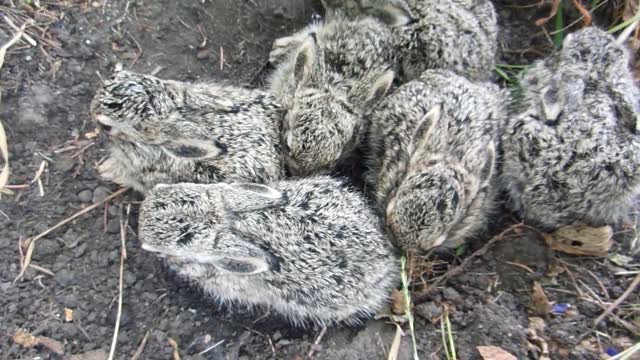Premium Only Content

Adorable Jackrabbit Babies Waiting For Mom Morning Breakfast
Jack rabbits are true hares because, unlike the cotton tailed rabbits, they do not build nests. The mother simply chooses a place to her liking and the young are born fully furred, with their eyes wide open.
Despite their name, jack rabbits aren't true rabbits. They are hares, distinguished by long, arched backs and extra-large hind feet. The long ears from which they got their name after being likened to jack donkeys are essential for survival, both for cooling and for hearing predators approach. Compared with humans, they have relatively short lives, but they make up for it by reproducing rapidly.
The white-tailed jack is the largest of California's hares. It weighs from 6 to 8 pounds. In winter it is sometimes mistaken for the snowshoe rabbit, because, in the colder parts of its range, individuals turn completely white. The range of the white-tailed jack in California is restricted to the east side of the Sierra Nevada and Cascade ranges from Tulare County north to the Oregon border.
The snowshoe rabbit's range is a long narrow strip from the Oregon border down through the higher elevations of the Klamath, Cascade, and Sierra Nevada ranges as far south as Tuolumne County. There are a few snowshoe rabbits in the Warner Mountains in Modoc County. The snowshoe is seldom seen for it prefers to live in dense fir thickets, and in winter is isolated by deep snow.
Habitat
Unlike the black-tailed jack, which prefers to live in valleys and flat, open country, the white-tailed jack lives in the hills and mountains. In their summer coat, in areas where the ranges of these two jack rabbits overlap, there may be some confusion as to identity. However the two may be distinguished by the color of the underside of their tails. The tail of the black-tailed jack is brownish underneath; the tail of the white-tailed jack is white.
The snowshoe rabbit is more easily identified as it is the smallest hare. It looks more like a cottontail rabbit. Its ears are shorter than its head, but the underside of its tail is brown, not white like the cottontail.
The black-tailed jack rabbit is 18 to 25 inches long and is colored buff peppered with black above, and white below. The tail has a black stripe above. The ears are long and brown with black tips. The antelope jack is approximately the same size, but colored gray above with the lower sides mostly white. The face, throat and ears are brownish, but there is no black tip on the ears.
As solitary animals, jack rabbits don't spend time together before or after mating. During mating periods, however, the males and females chase each other in a playful manner before actually mating. Females usually mate multiple times per year, having between four and six litters every year, depending on climate conditions. In temperate climates, jack rabbits breed year-round, but in colder areas breeding takes place between December and September.
The gestation period varies slightly between species but is typically around 40 days. The white-tailed jack rabbit (Lepus townsendii), which is the most common, has a gestation period of 36 to 43 days, with the average being 42 days. The black-tailed jack rabbit (Lepus californicus) has a slightly longer gestation period, lasting 41 to 47 days with an average of 43 days. Litter sizes vary greatly depending on the individual rabbit; litter size for a white-tail jack rabbit ranges from one to 11 and averages five; the black-tail jack rabbit normally has one to eight young per litter, averaging two or three.
-
 0:11
0:11
xXBronxmanXx
4 years agoMorning Breakfast
20 -
 LIVE
LIVE
Tundra Tactical
1 hour ago $0.68 earnedTundra Talks New Guns and Remembers Charlie Kirk On The Worlds Okayest Gun Show Tundra Nation Live
284 watching -
 DVR
DVR
DDayCobra
2 hours ago $10.64 earnedDemocrats Caught LYING Again About Charlie Kirk's KILLER
16.2K17 -
 19:23
19:23
DeVory Darkins
4 hours ago $2.40 earnedShocking Update Released Regarding Shooter's Roommate as Democrats Issue Insane Response
4.2K74 -
 19:53
19:53
Stephen Gardner
6 hours ago🔥EXPOSED: Charlie Kirk Shooter's Trans Partner Tells FBI EVERYTHING!
13.4K115 -
 LIVE
LIVE
BlackDiamondGunsandGear
1 hour agoAfter Hours Armory / RIP Charlie Kirk / What we know
81 watching -
 29:09
29:09
Afshin Rattansi's Going Underground
1 day agoThe Political Life of Malcolm X: Busting the Myths (Prof. Kehinde Andrews)
4.62K12 -
 LIVE
LIVE
DLDAfterDark
2 hours agoThe Assassination of Charlie Kirk - Just What We KNOW
119 watching -
 1:33:56
1:33:56
MattMorseTV
3 hours ago $23.17 earned🔴Exposing his PARTNER IN CRIME.🔴
45K177 -
 1:26:51
1:26:51
vivafrei
7 hours agoCharlie Kirk Assassination - When Peaceful Discussion Becomes Impossible - With Jose Vege
71.6K159